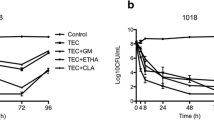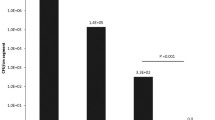Abstract.
Objective: Antibiotically coated or impregnated catheters are effective in eliminating gram-positive bacteria from their surfaces. However, their activity against gram-negative bacteria is not well known. The aim of this study was to evaluate and compare the adherence, persistence and colonization of Klebsiella pneumoniae on catheter surfaces and also to assess bacteriostatic and bactericidal levels. Design: Randomized, controlled, laboratory study. Setting: University surgical microbiology laboratory. Subjective: Silver sulfadiazine-chlorhexidine impregnated (SSC), minocycline and rifampin bonded (M+R), silver, platinum and carbon incorporated (SP+C) and non-antiseptic central venous catheter segments. Interventions: Catheter segments were immersed in 1 ml of phosphate buffered saline (0.01 mol/l) with 0.25% dextrose (PBSD) and incubated at 37°C. The PBSD was replaced daily. Effluents were frozen at –70°C for subsequent determination of bacteriostatic and bactericidal activity. On days 1,3,7,14 and 21 after initial immersion, 1 ml standardized inoculum of Klebsiella pneumoniae was added to 90 tubes for a period of 30 min. The inoculum was then replaced with PBSD. One third of the samples were immediately sonicated and plated for the determination of bacterial adherence. The remaining segments were incubated for 4 and 24 h, followed by the same procedure to determine bacterial persistence and colonization with time. All plates were read after 24 h of incubation. Measurements and results: There was a significant reduction in initial bacterial adherence for SP+C catheters on all days (p<0.05). SSC catheters prevented initial bacterial adherence for the first 7 days only (p<0.05). SSC and SP+C catheters prevented bacterial persistence and further colonization on all days. However M+R catheters prevented bacterial colonization for 3 days only. Effluent studies indicated that the impregnated agents in catheter SSC were bactericidal compared to catheter M+R, which were bacteriostatic to K. pneumoniae. No antibacterial activity was detected in the effluents from catheter SP+C. Conclusions: SSC and SP+C catheters are effective in eliminating K. pneumoniae from their surfaces for at least 21 days. M+R catheters are less effective in eliminating bacterial adherence and colonization may be due to their bacteriostatic property.
Similar content being viewed by others
Author information
Authors and Affiliations
Additional information
Electronic Publication
Rights and permissions
About this article
Cite this article
Yorganci, K., Krepel, C., Weigelt, J.A. et al. Activity of antibacterial impregnated central venous catheters against Klebsiella pneumoniae . Intensive Care Med 28, 438–442 (2002). https://doi.org/10.1007/s00134-002-1243-4
Received:
Accepted:
Published:
Issue Date:
DOI: https://doi.org/10.1007/s00134-002-1243-4




